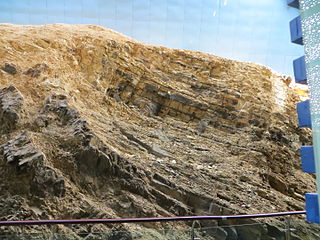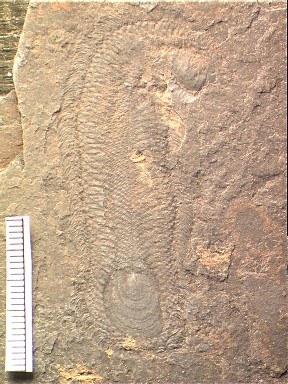
Bryozoa are a phylum of simple, aquatic invertebrate animals, nearly all living in sedentary colonies. Typically about 0.5 millimetres long, they have a special feeding structure called a lophophore, a "crown" of tentacles used for filter feeding. Most marine bryozoans live in tropical waters, but a few are found in oceanic trenches and polar waters. The bryozoans are classified as the marine bryozoans (Stenolaemata), freshwater bryozoans (Phylactolaemata), and mostly-marine bryozoans (Gymnolaemata), a few members of which prefer brackish water. 5,869 living species are known. At least two genera are solitary ; the rest are colonial.

The Cambrian Period is the first geological period of the Paleozoic Era, and of the Phanerozoic Eon. The Cambrian lasted 53.4 million years from the end of the preceding Ediacaran Period 538.8 million years ago (mya) to the beginning of the Ordovician Period 485.4 mya. Its subdivisions, and its base, are somewhat in flux.

Hallucigenia is a genus of lobopodian, known from Cambrian aged fossils in Burgess Shale-type deposits in Canada and China, and from isolated spines around the world. The generic name reflects the type species' unusual appearance and eccentric history of study; when it was erected as a genus, H. sparsa was reconstructed as an enigmatic animal upside down and back to front. Lobopodians are a grade of Paleozoic panarthropods from which the velvet worms, water bears, and arthropods arose.

The Maotianshan Shales (帽天山页岩) are a series of Early Cambrian sedimentary deposits in the Chiungchussu Formation, famous for their Konservat Lagerstätten, deposits known for the exceptional preservation of fossilized organisms or traces. The Maotianshan Shales form one of some forty Cambrian fossil locations worldwide exhibiting exquisite preservation of rarely preserved, non-mineralized soft tissue, comparable to the fossils of the Burgess Shale of British Columbia, Canada. They take their name from Maotianshan Hill in Chengjiang County, Yunnan Province, China.

Nectocaris is a genus of squid-like animal of controversial affinities known from the Cambrian period. The initial fossils were described from the Burgess Shale of Canada. Other similar remains possibly referrable to the genus are known from the Emu Bay Shale of Australia and Chengjiang Biota of China.

The Doushantuo Formation is a geological formation in western Hubei, eastern Guizhou, southern Shaanxi, central Jiangxi, and other localities in China. It is known for the fossil Lagerstätten in Zigui in Hubei, Xiuning in Anhui, and Weng'an in Guizhou, as one of the oldest beds to contain minutely preserved microfossils, phosphatic fossils that are so characteristic they have given their name to "Doushantuo type preservation". The formation, whose deposits date back to the Early and Middle Ediacaran, is of particular interest because it covers the poorly understood interval of time between the end of the Cryogenian geological period and the more familiar fauna of the Late Ediacaran Avalon explosion, as well as due to its microfossils' potential utility as biostratigraphical markers. Taken as a whole, the Doushantuo Formation ranges from about 635 Ma at its base to about 551 Ma at its top, with the most fossiliferous layer predating by perhaps five Ma the earliest of the 'classical' Ediacaran faunas from Mistaken Point on the Avalon Peninsula of Newfoundland, and recording conditions up to a good forty to fifty million years before the Cambrian explosion at the beginning of the Phanerozoic.

The halkieriids are a group of fossil organisms from the Lower to Middle Cambrian. Their eponymous genus is Halkieria, which has been found on almost every continent in Lower to Mid Cambrian deposits, forming a large component of the small shelly fossil assemblages. The best known species is Halkieria evangelista, from the North Greenland Sirius Passet Lagerstätte, in which complete specimens were collected on an expedition in 1989. The fossils were described by Simon Conway Morris and John Peel in a short paper in 1990 in the journal Nature. Later a more thorough description was undertaken in 1995 in the journal Philosophical Transactions of the Royal Society of London and wider evolutionary implications were posed.

Dasycladales is an order of large unicellular green algae in the class Ulvophyceae. It contains two families, the Dasycladaceae and the Polyphysaceae.

The Chancelloriids are an extinct family of superficially sponge-like animals common in sediments from the Early Cambrian to the early Late Cambrian. Many of these fossils consists only of spines and other fragments, and it is not certain that they belong to the same type of organism. Other specimens appear to be more complete and to represent sessile, radially symmetrical hollow bag-like organisms with a soft skin armored with star-shaped calcareous sclerites from which radiate sharp spines.
The small shelly fauna, small shelly fossils (SSF), or early skeletal fossils (ESF) are mineralized fossils, many only a few millimetres long, with a nearly continuous record from the latest stages of the Ediacaran to the end of the Early Cambrian Period. They are very diverse, and there is no formal definition of "small shelly fauna" or "small shelly fossils". Almost all are from earlier rocks than more familiar fossils such as trilobites. Since most SSFs were preserved by being covered quickly with phosphate and this method of preservation is mainly limited to the late Ediacaran and early Cambrian periods, the animals that made them may actually have arisen earlier and persisted after this time span.
The cephalopods have a long geological history, with the first nautiloids found in late Cambrian strata, and purported stem-group representatives present in the earliest Cambrian lagerstätten.
Cambroclaves are a group of enigmatic, phosphatized, hollow spine-shaped sclerites, known from their geographically widespread Early to Middle Cambrian fossils, which occur exclusively in shallow waters within the photic zone. They were probably originally aragonitic. They are lobate with long spines protruding centrally; these spines are in some cases pillar-like, constituted of a bundle rods with an Ionic-like appearance. Some taxa have been compared to spicules of ecdysozoan worms, whereas others likely belong to Protomelission-like organisms, which have been argued to be affiliated with the dasycladalean green algae and the bryozoans.


In archaeogenetics, the term Ancient North Eurasian (ANE) is the name given to an ancestral component that represents the lineage of the people of the Mal'ta–Buret' culture (c. 24,000 BP) and populations closely related to them, such as the Upper Paleolithic individuals from Afontova Gora in Siberia. Genetic studies indicate that the ANE are closely related to the Ancient North Siberians (ANS) represented by two ancient specimens from the preceding Yana Culture (c. 32,000 BP). The ANE can either be considered to descend from the earlier ANS population, or that both ANE and ANS are closely related, albeit differentiated, sister lineages, with both having originated from an 'Early West Eurasian' hunter-gatherer lineage (represented by Kostenki-14, c. 40,000 BP), which absorbed an 'Early East Eurasian' population (represented by the Tianyuan man, c. 40,000 BP). The ANS and ANE each derive between 18% to one third of their ancestry from an Early East Eurasian lineage and between two thirds to 82% from an Early West Eurasian lineage.
In solid-state physics, the kagome metal or kagome magnet is a type of ferromagnetic quantum material. The atomic lattice in a kagome magnet has layered overlapping triangles and large hexagonal voids, akin to the kagome pattern in traditional Japanese basket-weaving. This geometry induces a flat electronic band structure with Dirac crossings, in which the low-energy electron dynamics correlate strongly.

Acinocricus is a genus of extinct worm belonging to the group Lobopodia and known from the middle Cambrian Spence Shale of Utah, United States. As a monotypic genus, it has one species Acinocricus stichus. The only lobopodian discovered from the Spence Shale, it was described by Simon Conway Morris and Richard A. Robison in 1988. Owing to the original fragmentary fossils discovered since 1982, it was initially classified as an alga, but later realised to be an animal belonging to Cambrian fauna.

Hallucigeniidae is a family of extinct worms belonging to the group Lobopodia that originated during the Cambrian explosion. It is based on the species Hallucigenia sparsa, the fossil of which was discovered by Charles Doolittle Walcott in 1911 from the Burgess Shale of British Columbia. The name Hallucigenia was created by Simon Conway Morris in 1977, from which the family was erected after discoveries of other hallucigeniid worms from other parts of the world. Classification of these lobopods and their retatives are still controversial, and the family consists of at least four genera.
Shuhai Xiao is a Chinese-American paleontologist and professor of geobiology at Virginia Tech, Blacksburg, Virginia, U.S.A.













